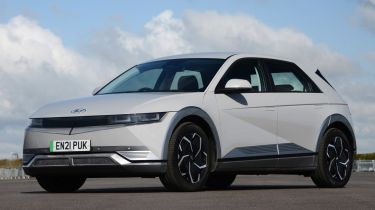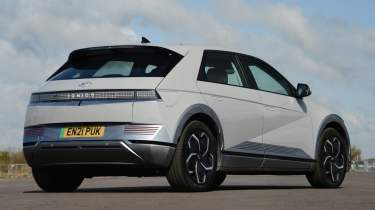Used Hyundai Ioniq 5 (Mk1, 2021-date) buyer’s guide: award-winning EV is still a great buy
A full used buyer’s guide on the Hyundai Ioniq 5 that has been on sale since 2021
Verdict
The Hyundai Ioniq 5 is a hugely desirable model, which has won a raft of awards from Auto Express. In our 2021 New Car Awards it was Car of the Year, Premium Electric Car of the Year, Mid-Size Company Car of the Year and it scooped our Design Award. With its distinctive styling, user-friendly cabin, long warranty, fast charging (350kW as standard) and excellent reliability, the Ioniq 5 is the sort of car that might persuade the doubters that electric cars are here to stay. Relatively high purchase prices limit its appeal as a new buy, but as a used proposition the Ioniq 5 is a great option.
Within three days of Hyundai unveiling the Ioniq 5 in February 2021, the company had received 236,000 expressions of interest, and in just 24 hours the first 3,000 cars had been oversubscribed three times over. Most of this was on the strength of a striking exterior design and a promising spec, but when the first reviews of the car were published, it was clear that the Ioniq 5 had the substance to back up the style. Over the past four years the Ioniq 5’s design has refused to age and the hatch has continued to wow owners as much as it has impressed us; could it be a classic in the making?
History
The Ioniq 5 went on sale in June 2021, with 58kWh or 73kWh battery packs. The former came only in 168bhp rear-wheel-drive form, the latter with rear or four-wheel drive, and either 214bhp or 301bhp. From February 2022 an improved battery-conditioning system was fitted, while top-spec cars got a 77.4kWh pack.
Used - available now

2024 Hyundai
Ioniq 5
23,816 milesAutomaticElectric
Cash £18,787
2022 Hyundai
Ioniq 5
37,964 milesAutomaticElectric
Cash £20,787
2022 Hyundai
Ioniq 5
26,173 milesAutomaticElectric
Cash £19,200
2022 Hyundai
Ioniq 5
17,196 milesAutomaticElectric
Cash £23,676In October 2023 Hyundai launched the most engaging EV so far: the £65,000 Ioniq 5 N, with an 84kWh battery and twin motors that could generate up to 641bhp and 740Nm.
A facelifted Ioniq 5 was introduced in July 2024, with entry-level models getting a 63kWh battery pack, better thermal management of the battery, and refreshed exterior styling.
On the road
The Ioniq 5 is a heavy car and sometimes it feels it, but generally it’s easy and enjoyable to drive, and even in entry-level form it’s quick enough. The handling isn’t all that sharp (N edition aside), because Hyundai has wisely opted to focus on ride comfort instead.
The minimum real-world range you can expect is around 200 miles, with 300-plus miles on the cards if you opt for a car with one of the bigger battery packs.
Which one should I buy?
Whereas the rear-wheel-drive models have 350Nm of torque, the four-wheel-drive Ioniq 5 has 605Nm and can cover 0-62mph in just 5.2 seconds. All Ioniq 5s are restricted to 115mph, apart from the N which tops out at 161mph.
Standard equipment is generous, with even the entry-level SE Connect featuring 19-inch alloy wheels, dual-zone climate control, wireless phone charging, rear parking sensors and a camera plus adaptive cruise control. Premium trim adds electric driver’s seat adjustment, heated front seats and steering wheel, front parking sensors and a powered tailgate. Finally, Ultimate trim brings leather upholstery, a BOSE hi-fi, heated outer rear seats, electric adjustment on the front passenger seat, ventilated front seats and a head-up display.
Alternatives to the Hyundai Ioniq 5
The Kia EV6 comes with an even better warranty, fast charging and a brilliant real-world range. The Volkswagen Group can offer you the Skoda Enyaq, Volkswagen ID.4, Audi Q4 e-tron and Cupra Born, all of which offer a user-friendly cabin, a decent driving experience and (in the main) a high-quality interior, but some digital displays seem like overkill.
Shop with Stellantis and you can choose from the Vauxhall Mokka-E, Citroen e-C4, Peugeot E-2008 and DS 3 E-Tense. Or how about the Ford Mustang Mach-E, Nissan Ariya, Toyota bZ4X, Renault Scenic, Genesis GV60, Tesla Model Y and BYD Atto 3? All are worth a look and a test drive.
Use our valuation tool to check the price of a Hyundai Ioniq 5
What to look for
Towing limits
Unlike many EVs, the Ioniq 5 is able to tow. Cars with the smaller battery can pull up to 750kg; those with the bigger battery can tow 1,600kg.
Camera option
From February 2022, cameras were available in place of the regular door mirrors. These relayed images onto a digital screen on the dashboard.
Heat pump
The optional £1,200 Eco Pack came with battery heating and a heat pump, which recaptures heat from the motor and offers a useful boost to the winter range.
Extra trim levels
The 2024 facelift added an N Line option, with sportier detailing than the regular Ioniq 5; all changes were cosmetic. The luxurious £53k Namsan joined the range in 2022; both are rare on the used market.
Interior
The Ioniq 5’s interior is ultra-modern, with the dashboard dominated by a pair of 12.3-inch digital displays, one for the infotainment, the other for the instrumentation. It’s intuitive, clearly laid out and incorporates information on the huge array of standard safety features.
Many car makers offer black cabin trim with no alternatives, but not Hyundai, which has opted for a light grey, which really brightens up the interior – although it marks quite easily.
Cabin versatility is improved by the ability to slide the rear seats back and forth by up to 135mm, while the boot capacity is excellent, at 527 litres with the rear seats in use, or 1,587 litres with them folded flat; there’s also a 57-litre storage area under the bonnet.
Running costs
The Ioniq 5 needs to be serviced every two years or 20,000 miles, although an optional 12-month or 10,000-mile service is also available for £104. Stick with maintenance every year and services alternate between Minor and Major at £227 and £581. Both include fresh brake fluid; the latter includes new battery coolant, which is due every four years.
All Ioniq 5s will be subject to VED from April 2025, at the rate of £195 per year. Most Ioniq 5s cost more than £40,000 new, and although the annual £410 luxury car tax supplement won’t be levied against cars registered before 1 April 2025, models after that will be liable.
Insurance groups are fairly high at 29-41, although unsurprisingly, the Ioniq 5 N sits in group 49, so you’ll pay plenty to cover one of these.
Recalls
Hyundai has recalled the Ioniq 5 four times so far, initially in June 2022 because more than 6,000 cars left the factory with a faulty handbrake; the fix was a software update.
The second recall came in March 2023, because some Ioniq 5s made between July and November 2022 had incorrect VIN labels.
Two recalls were issued in May 2024, the first because more than 16,000 Ioniq 5s made up to February 2024 potentially had a faulty charging control unit that could lead to the car going into limp mode. The other recall was because of sub-standard driveshafts fitted to some Ioniq 5s made in 2023.
Driver Power owner satisfaction
The Ioniq 5 hasn’t appeared in Driver Power; in our 2024 poll Hyundai didn’t appear at all. It was in our 2023 survey, with the Kona coming 16th out of 75, while the Ioniq managed 11th. There’s one owner review on CarBuyer.co.uk – a ringing endorsement with the maximum five stars.
SEE OUR LATEST USED HYUNDAI IONIQ 5 DEALS
Did you know you can sell your car with Auto Express? Get the highest bid from our network of over 5,500 dealers and we'll do the rest. Click here to try Auto Express Sell My Car now...












